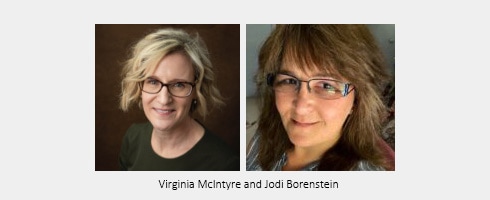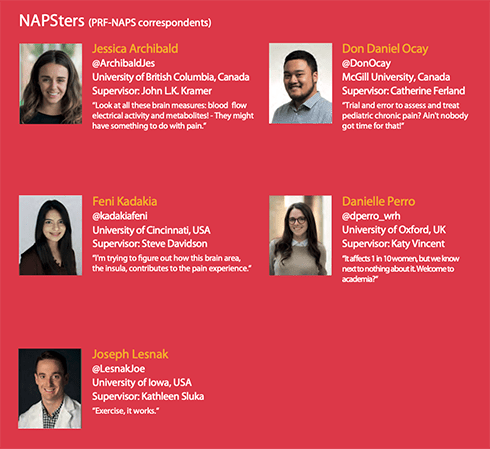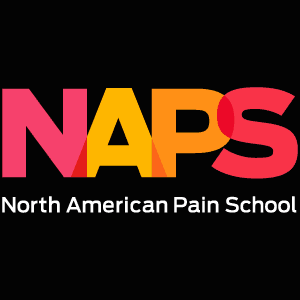Five early-career pain researchers are participating in the PRF-NAPS Correspondents program during the 2022 North American Pain School, taking place 19-24 June in Montebello, Québec City, Canada. The Correspondents program is a unique science communication training program that provides participants with knowledge and skills needed to communicate science effectively to a wide range of pain researchers, patients, and the greater public. The Correspondents will conduct interviews with NAPS Visiting Faculty and Patient Partners, write summaries of scientific lectures – and provide live blogging, too! Take a look at their blog posts from day 2 at NAPS below.
NAPS Blog Posts: Day 2
Sodium Channel Blockers and Patient Partners: Day 2 at NAPS
What Happens Behind Closed Doors….
A Thank You Letter to our Patient Partners at NAPS
This year’s theme at NAPS is “Controversies in Pain.” What could be more controversial than moving away from what is considered a major pillar of the scientific process?
Peer review is the system used to assess the quality of a manuscript before it is published. In theory, this process allows for experts in the area to evaluate validity and significance, and also helps editors determine whether a manuscript should be published in their journal. In practice, this can (at times) influence the interpretation of the research. For example, what if a reviewer advises you to adjust the interpretation of your findings to a degree you may not agree with? Pulling the paper, and resubmitting elsewhere, comes at a time cost that negatively impacts the trainee.
Of course, this is not always the case. Often, scientists feel that the quality of their work is improved by the peer-review process. But is there another way? Some “sweet spot” we haven’t found yet? Some people think there is.
bioRxiv (pronounced “bio-archive”) is an open access preprint repository founded in 2013. In this space, papers can be hosted before they are peer reviewed, and readers can offer their comments. A similar framework exists in other fields, such as mathematics and physics. This also allows readers to assess the initial intentions and interpretations of the scientists.
Would you consider publishing preprints of your work prior to the review process?
Jessica Archibald is a PhD candidate at the University of British Columbia, Canada. You can follow her on Twitter – @ArchibaldJes
Sodium Channel Blockers and Patient Partners: Day 2 at NAPS
Day 2 of NAPS in the books. All of our student presentations are complete, and I cannot stress enough how impressed I am with everyone here. There’s such a diverse representation of clinical and basic scientists, and I’ve had a ton of constructive conversations.
We were fortunate to hear from Visiting Faculty member Rajesh “Raj” Khanna, PhD (New York University, US), who presented his work on the development of drug targets for sodium channel blockers for pain relief. Raj did an amazing job simplifying preclinical research and explaining why previous sodium channel blockers have failed in clinical trials. Personally, I view Raj as a great role model for pioneering scientific techniques and for his ability to talk about his work with a diverse audience.
In the evening, we had a powerful learning experience talking with our Patient Partners – Virginia McIntyre (@Virginia_McI) and Jodi Borenstein (@JodiLB1969) – when we engaged in a Q&A session regarding their lived experiences with pain. As a basic scientist (who does not work with a patient population), I don’t typically have the opportunity to talk with individuals suffering with chronic pain. Hearing from Virginia and Jodi was an energizing reminder of why we have committed ourselves to the study of pain. Going forward, I would like to have more involvement with Patient Partners in my own research design and writing.
Joseph Lesnak, DPT, is a PhD candidate at the University of Iowa, US. You can follow him on Twitter – @LesnakJoe.
What Happens Behind Closed Doors….
Did you know that patients only get about 17 seconds to explain the reason for their visit before being interrupted by their doctors? This information blew my mind during the workshop presented by Yoram Shir, MD (McGill University, Montreal, Canada – @mcgillpainunit) on “Interviewing and Diagnosing Pain Patients.” During this session, Yoram allowed NAPSters to conduct an initial interview with our Patient Partners – Virginia McIntyre (@Virginia_McI) and Jodi Borenstein (@JodiLB1969) – as if they were meeting them for the first time as a clinician.
This session was eye opening. As a clinical researcher, I only know my experience of working with pediatric patients. This session, however, will forever change the way I approach patients. The importance of creating a rapport was highlighted several times throughout. Should you focus on a goal for the patient? Do you ask them their pain intensity on a scale from 0-10? Not necessarily.
The initial consultation should focus on getting to know the patient as much as possible. How long have they had this pain? How often do they have this pain? Do they have a support system? What methods do they use to cope with the pain? From there, you can understand the full picture rather than focusing on what may be a “magical solution.” Believe, acknowledge, and listen to your patient.
I would like to commend Virginia’s and Jodi’s bravery for sharing their story with us. I believe it was the first time for many of us researchers to learn what happens behinds the closed doors of a chronic pain patient clinic room.
Don Daniel Ocay is a PhD candidate at McGill University, Montreal, Canada. You can follow him on Twitter – @DonOcay
A Thank You Letter to our Patient Partners at NAPS
Before NAPS, I believed in the power, and frankly, the necessity of including patient voices at the forefront of research. People with lived experiences need to be included at the beginning, the middle, and the end of our projects. Today solidified my beliefs.
Amongst our busy schedule, the after-lunch swim, and the late night poutine, my favorite session revolved around the patient experience. We began our day with our Patient Partners – Virginia McIntyre (@Virginia_McI) and Jodi Borenstein (@JodiLB1969)– sitting down and letting a room of >30 people ask them questions about their experience. This could not have been an easy feat.
We discussed their participation in research, some of the challenges they face along the way, and how we as researchers can better support them. In addition to the organized sessions, I’ve loved seeing the conversations on Twitter between our Patient Partners and other NAPS attendees. While the information from some talks can take more time to “digest,” the back-and-forth on Twitter means that our conversations can continue after the session. This is the way forward.
Today, I feel gratitude. Virginia and Jodi… thank you. Thank you for sharing your lived experiences with us. As painful as they may be, your insight is invaluable. Rajesh Khanna… thank you for reminding me of The Tragically Hip! Always in view!
Danielle Perro is a fourth year PhD candidate at the University of Oxford, UK. You can follow her on Twitter – @dperro_wrh
As a basic science researcher, NAPS has introduced me to a few unfamiliar topics. Today began and concluded with workshops focused on patient care. In the morning, we had an “Ask-a-Patient” session with our two Patient Partners – Virginia McIntyre (@Virginia_McI) and Jodi Borenstein (@JodiLB1969).They shared how their pain developed, their lived experiences with chronic pain, and their clinical interactions. As someone who spends all day in the lab, this session was informative because it’s easy to feel removed from patients and the “big picture.” This session was a good reminder of what we’re working toward.
On the opposite spectrum, we also had a session hosted by Ted Price, PhD (University of Texas at Dallas, US) about entrepreneurship, in a tent! He talked about how scientists are in a great position to start their own companies, and the importance of having a good pitch to attract investors. We got to utilize this advice first-hand after we were put into groups to work on a pitch for our own “company.” While the rain and thunder made it a little difficult to hear the groups present their pitches, the laughs boomed. This was one of my favorite sessions at NAPS so far.
We ended our day with a workshop presented by Yoram Shir, who provided guidance on interviewing and diagnosing pain patients. Something that stuck out to me was how much time we spent trying to get to know the patients. Yoram said, “Every patient is his or her own individual. You have to learn who they are.” The takeaway – pain does not define us.
Feni Kadakia is a PhD student at the University of Cincinnati, Ohio, USA. You can follow her on Twitter – @KadakiaFeni
The 2022 NAPS Patient Partners

The 2022 PRF-NAPS Correspondents




